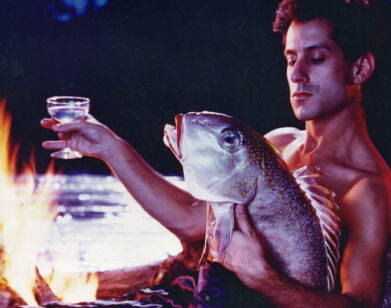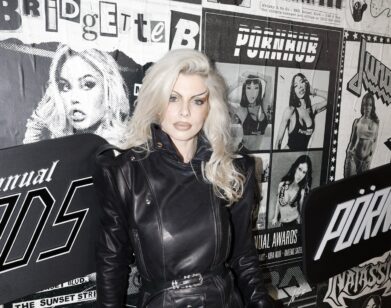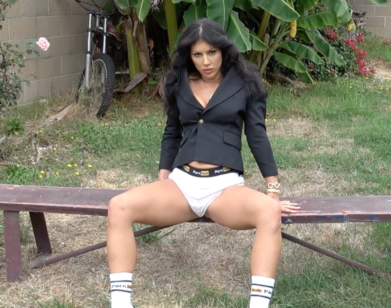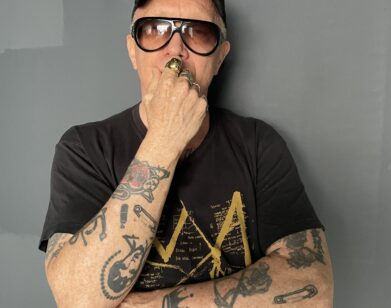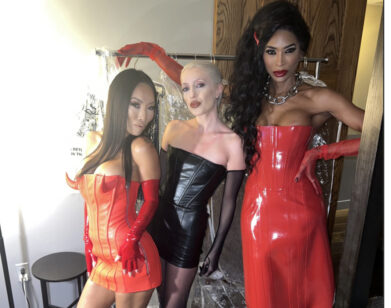Sexologist Annie Sprinkle Isn’t Covering Anything Up

Annie Sprinkle. All photos courtesy the artist.
There’s a lot more to Annie Sprinkle than her buxom physique. The legendary author, academic, activist, prostitute, and feminist filmmaker is a tour de force who revolutionized sex work and pornography forever. It all started when she moved to New York in 1973, entering the world of pornography out of sheer curiosity. Starring in over 200 adult films and spending 20 years as a sex worker, Sprinkle exhibited more sexual aggression than other porn actresses, refusing to play roles of submission. She squarely focused on the female orgasm, educating thousands on the pleasure of their partners.
But after making a career playing out others’ fantasies, Sprinkle started to focus on her own desire: becoming an artist. Throughout the 1980s and ’90s, she brought her signature attitude to the stage with a series of burlesque performances and a one-woman show which fused comedy, lingerie, and performance art. Sprinkle soon found herself gaining traction as one of the country’s first outspoken sex-positive feminists. She’s also the first self-proclaimed adult film star to get a PhD. (She’s a certified sexologist and has the low-cut lab coat to prove it.) Ever since, she’s been working as a sex educator and lecturer worldwide.
Sprinkle is now being featured in the forthcoming exhibition ON OUR BACKS: The Revolutionary Art of Queer Sex Work, opening September 28 at the Leslie Lohman Museum in New York. The group show, which features over 200 artworks and objects, explores the history of queer sex work and its culture, art, and activism. Sprinkle is showing paraphernalia from her career in sex work, which includes business cards, Polaroids, and a “tit print,” among other things. Sprinkle spoke candidly to Interview about her recovery from lung cancer, the advice she gave to Maggie Gyllenhaal on set of The Deuce, and what Times Square was really like in the 1970s.
———

NADJA SAYEJ: So, you’re showing in this group show about queer sex work. What can we expect to see?
ANNIE SPRINKLE: Well, there’ll be a vitrine of ephemera over my sex worker career, including business cards, photos, contact sheets, jewelry. Just odds and ends, I sent them a box of Polaroids, so they’re going to make a vitrine. The centerpiece is a photo my photo my partner Beth Stephens made for a piece she made called “Whose Zooming Who?” about the female gaze in 1992, when everyone was talking about the male gaze. She made this piece about the female gaze—which, wasn’t that different than the male gaze [Laughs], in a way. It’s a beautiful photo of both of us sitting on her motorcycle. To me, that’s the main piece. The curator [Alexis Heller] wanted to show how sex workers were interacting and working with artists. Beth is an artist. We weren’t partners then but we did this shoot in 1992, decades ago, and we stayed friends and became partners 18 years ago, as well as full on 50-50 collaborators. To me, that’s the most important piece personally.
SAYEJ: Wow. Where did this all start for you?
SPRINKLE: I was a porn star and worked in massage parlors and did prostitution for 22 years in the mainstream sex industry in Manhattan. At one point, I did my first one-woman show, Post Porn Modernist. I sold all the ephemera to an art collector named Bob; it went off to Ohio. I got $10,000 to sell the suitcase of ephemera and I was just thrilled. I did the show in 20 countries over several years, I toured it from 1989 to 2004. It was kind of the first full-on theatre piece by a sex worker who plays herself. It was performance arty because I showed my cervix to the audience and did a sex magic masturbation ritual. I sold the suitcase with the slides, the costumes, the shoes, sent it off to Ohio and hadn’t seen it since but the curator wanted to show it, so she convinced the art collector to loan it for the exhibition. So, there’ll be highlights from my show and the ephemera from that, too.
SAYEJ: What was the reception like for Post Porn Modernist when you launched it in 1989? Were they uptight?
SPRINKLE: Not at all. People loved it. All my shows were packed, sold out. It was all the rage. The art world welcomed me with open arms. Of course, it was controversial in that some senators and government people called it “a sewer of depravity” and a live sex show, which it wasn’t at all [Laughs]. But they didn’t see it. It was in the National Enquirer and there was a lot of controversy between the right-wing politicians trying to take away public funding for the arts, which they successfully did. They clobbered the National Endowment for the Arts. My show was one of the arguments for taking away the funding. If you look up NEA Four on Wikipedia, it talks about that fight at the time. I was just trying to do a performance about my life and work, sex work, which is what it was. People tried to stop it, there were police in the audience sometimes. I was showing my cervix, but I never got arrested. I did censor myself because I didn’t want to get arrested, because I had tickets to Europe the next day or something. [Laughs.] But it was edgy performance art. People loved it!
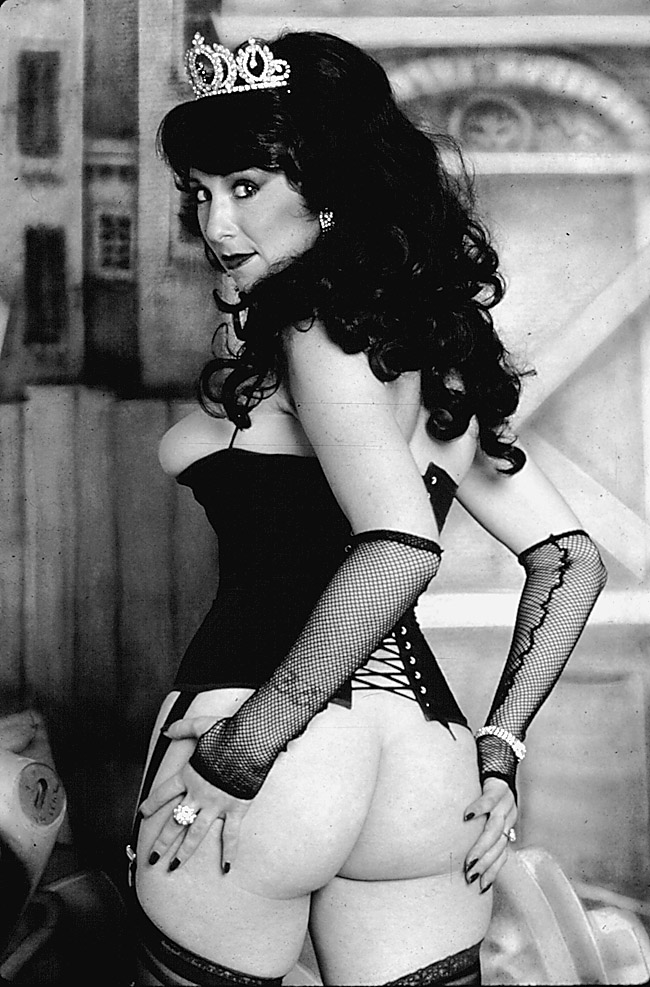
SAYEJ: What was going on at the time in New York?
SPRINKLE: At the time, it was 1990. AIDS had hit, it was very sex positive and sexually explicit and played in highbrow theaters like the Kitchen and other professional arts venues. I’d like to think I brought the lowbrow into the highbrow. That made it interesting, and people will be able to see that here in this exhibition. The curator, Alexis Heller, also wanted to include something about this thing I had called the Sprinkle Salon. The Sprinkle Salon was a lively place. The prostitutes of New York met there, we had pornographers promoting safer sex there, my, or the first, porn star support group Club 90 met there, too, which was named after 90 Lexington Avenue, where my apartment was at 27th Street. I did a lot of photo shoots there, as I worked as a photographer for the sex magazines, and I went to the School of Visual Arts. But it was also a tattoo parlor! It was a big hub of art and creativity. A lot of people who came to New York would stay in my guest room. I had a bed and breakfast for the community.
SAYEJ: I think the exhibit covers the crossover between art and activism. Have sex workers been getting more rights as of late?
SPRINKLE: No, they’re losing ground. They’re not getting more rights. But Carol Leigh, also known as the Scarlot Harlot, who invented the term “sex work”—she’s also in this exhibition. I think many artists in the show are also sex workers, or artists who interact with sex workers. Veronica Vera, one of my best friends, is also in the show. She has an academy in New York, Miss Vera’s Finishing School for Boys Who Want to Be Girls. We went through the AIDS crisis together, we did a lot of journalism. We called ourselves “The High-Heeled School of Journalism.” We did a lot of magazine work; I did the photography and she did the writing. Times Square was our main beat. You know the HBO series The Deuce?
SAYEJ: Yeah, with Maggie Gyllenhaal and James Franco?
SPRINKLE: Yeah, well Veronica Vera and I were both paid consultants for the show, or should I say “con-slut-tants?” [Laughs]. They saw our documentation; we were very much part of that scene in Times Square. I spoke to Maggie Gyllenhaal, and I explained to her that I was following clit, my muse, but also that it was my creative impulse. She said that really helped her and her character to think about being driven by the creative impulse. But the writers were certainly influenced by sex worker culture and Candida Royalle [a feminist porn director], especially, I think and the whole Times Square is great history. Do you ever go to Times Square?
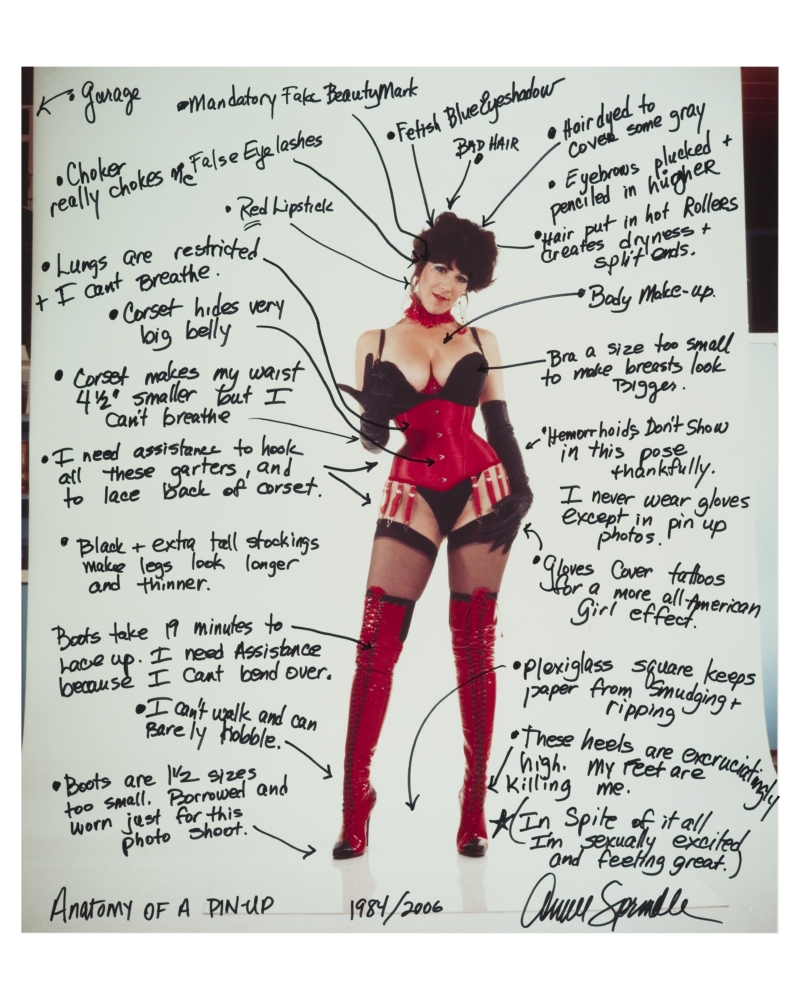
SAYEJ: Yes, but wasn’t it Fran Lebowitz who said when New Yorkers run into each other in Times Square, they feel the need to make excuses of why they’re there?
SPRINKLE: It was a totally different place in the 1970s and 1980s. I moved to New York in 1973, and my first day that I moved to New York, I was Gerard Damiano mistress, so my first few nights in New York were at a hotel in Times Square. And I fell in love with Times Square.
I just turned 65. The nice thing about this exhibition is that a lot of these younger sex workers don’t know about the history. Of course we all think we’re inventing everything, with young sex workers who are all about race and class now, but a lot of the early work from COYOTE (Call Off Your Old Tired Ethics), a sex workers rights group founded by Margo St. James in 1973, was about race and class, too. But young people today don’t realize that. They don’t know the history. I’m loving what the curator is doing with this exhibition, including the history of sex work alongside the current stuff. Sex workers have influenced artists, culture and art. Artists like Peaches have been influenced by early sex worker art, I’d say. There’s sex worker culture. The person installing mine and Vera’s art was part of the New York Healing Circle together, we made regular newsletters, which was called In the Circle during the AIDS crisis, where we lost a lot of friends and lovers. I think AIDS was an important part of that time. I think sex work influenced Madonna…
SAYEJ: Cardi B?
SPRINKLE: Cardi B was a sex worker. I don’t know how much exposure she had to sex worker art and culture, but I can’t wait to see her movie, Hustlers. That certainly ties in. There’s also a Sex Worker Film Festival, which has been going on for many years, founded by Carol Leigh. You know how there’s gay film festivals now? We even have gay characters on TV. I do think those film festivals of gay culture influences the mainstream enormously. Now you’re able to see sympathetic sex worker characters onscreen. That’s because sex workers are making movies about their own lives. Even The Deuce—that has been influenced by sex worker art and culture, in a way.
SAYEJ: You showed artwork recently in Documenta, right?
SPRINKLE: Beth and I got to show at Documenta 14 in Germany, and we did a whole bunch of things over the nine-month exhibition. We did a visual art installation of our work, a movie premiere of our new film Water Makes Us Wet and we cuddled people between us in a bed in a big museum lobby as art for seven minutes a piece—an anti-Trump wall protest of sorts. We also did an outdoor theater piece called Ecosex Walking Tour with a team of fantastic international performance artists. In my opinion, Documenta is the best exhibition in the whole world. It’s only once every five years, so I can die now! [Laughs]. I was in it, what year? Actually, I get emotional when thinking about it [voice cracks up]. I was thinking about where I came from, but it was always the creative impulse for me, with sex work. It always came from the creative impulse. For me, prostitution and pornography were creative. Prostitution was private performance art and theater, you know? It’s all the same. But my grandfather was an artist, my parents were creative, I went to a lot of art museums growing up. For a long time, I never thought I was an artist because I thought someone else had to call you that. You couldn’t call yourself that, it would be egotistical. Eventually, I got my degree in fine arts.
SAYEJ: What else are you up to these days?
SPRINKLE: I’m going to Japan this week to do a big eco-sex show and then in a few weeks, I’m going to Austria to talk about our eco-sex project. There’s a whole network of eco-sexual artists doing interesting things, like Betty Grumble. There’s an artist in Taiwan who was recently at the Hong Kong protests who makes videos of men who make love with ferns. They’re incredible. He’s an art professor. There’s sex toys for plants and porn for plants, we’re going to make an installation in Japan next year about that.
SAYEJ: What else is happening?
SPRINKLE: I’m working on finishing a book and getting my archive together, but I also just had lung cancer surgery.

SAYEJ: What? OMG! Are you okay?
SPRINKLE: I’m okay. I’m technically cancer free, but I have other health issues. I have to get my ovaries out, there’s a lot of medical work and screenings. I had breast cancer and I had lung cancer, so I’m not going to be around forever. I want to get my archive organized and placed. Interestingly, Harvard’s Schlesinger Library has been collecting sex worker archives, so I’m hoping to place my archive to them because they have Candida Royalle’s work there, as well as Margo St. James. They now have a great collection of sex worker materials. I know I’ve been very privileged up the wazoo, a lot of luck. I think I really succeeded making a bridge between sex worker art and culture and the mainstream art world, which isn’t everybody’s thing. A lot of sex workers don’t care about the art world, but I kind of love it. It has been good to me. I feel more creative freedom in art than there is in sex history.
SAYEJ: I’m happy to hear that because the art world can be a really confining place with no sense of humor.
SPRINKLE: Ha! Well, my boyfriend in the 1970s was the European chairman of Fluxus, Willem de Ridder, so I learned about art largely from him. I’m really Fluxus influenced. One of the things I’m showing is one of my Tit Prints, I made thousands of them and I sold them at my shows and in galleries for cheap, like for $100 or $500. It was a concept I made up with de Ridder, using stencils, so there’s cubist and heart-shaped, abstract tit prints. We had a blast making them and I did them up until last year. I retired the tit prints [Laughs]. They’re made with non-toxic ink, many of them aren’t archival. A few early on were made with permanent ink, maybe that’s why I got breast cancer possibly.
SAYEJ: OMG.
SPRINKLE: Well, a lot of artists died from their materials, you know. A lot of artists died from toxic fumes, paint, paint thinners, silkscreen artists. I don’t know if that’s why I got breast cancer, but it’s possible. For the record, I’m quite healthy, but I just have to focus more on health than art. I’ve worked really hard my whole life to do work, but now I’m kind of pulling back. But I am healthy, technically.


